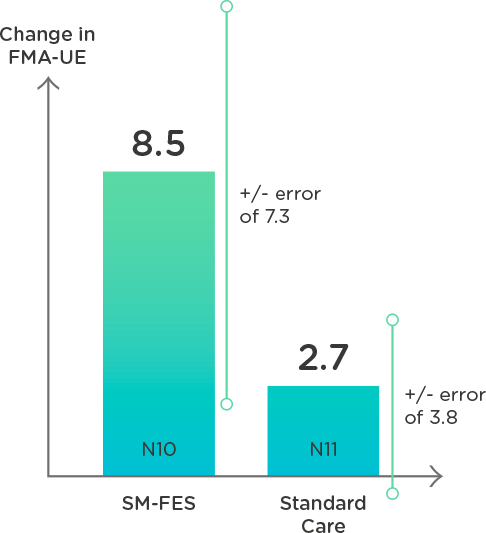Note: Intento Movement Therapy can be found in the literature with the name of Electrically-assisted movement therapy.
Objective
To evaluate the effects of a therapy based on self-modulated functional electrical stimulation. In this therapy, patients use functional electrical stimulation, modulated by a custom device controlled through the patient’s unaffected hand, to produce or assist task-specific upper limb movements, which enables them to engage in intensive goal-oriented training.
Design
Randomized, crossover, assessor-blinded, 5-week trial with follow-up at 18 weeks.
Participants
Patients with chronic, severe stroke (N=11; mean age, 47.9 years) more than 6 months poststroke (mean time since event, 46.3 months).
Interventions
Both the therapy based on SM-FES and the control intervention (dose-matched, goal-oriented standard care) consisted of 10 sessions of 90 minutes per day, 5 sessions per week, for 2 weeks. After the first 10 sessions, group allocation was crossed over, and patients received a 1-week therapy break before receiving the new treatment.
Main Outcome Measures
Fugl-Meyer Motor Assessment for the Upper Extremity, Wolf Motor Function Test, spasticity, and 28-item Motor Activity Log.
Results
Forty-four individuals were recruited, of whom 11 were eligible and participated. Five patients received the experimental treatment before standard care, and 6 received standard care before the experimental treatment.
The therapy based on SM-FES produced higher improvements in the Fugl-Meyer scale than standard care (P<.05). Median improvements were 6.5 Fugl-Meyer points and 1 Fugl-Meyer point after the experimental treatment and standard care, respectively.
The improvement was also significant in subjective reports of quality of movement and amount of use of the affected limb during activities of daily living (P<.05).

Conclusions
Therapy based on SM-FES produces a clinically important impairment reduction in stroke patients with chronic, severe upper limb paresis.

